Human Resource Management: HRM Functions, Practices & Effectiveness
VerifiedAdded on 2022/12/29
|16
|4544
|1
Report
AI Summary
This report provides a detailed analysis of Human Resource Management (HRM) functions within the context of TESCO, a multinational grocery and general merchandise retailer. It covers the purpose and function of HRM, its application to company planning and resourcing, and evaluates the strengths and weaknesses of different recruitment and selection approaches. The report also examines the advantages of various HRM practices and methods for both employers and employees, assessing the effectiveness of these methods in increasing profitability and output. Furthermore, it discusses the significance of employee relations in impacting HRM decision-making and highlights major components of employment legislation and their impact on the HRM decision-making process. The report concludes by exploring the utilization of HRM in the context of various operations conducted at TESCO, providing a comprehensive overview of HRM's strategic role within the organization. Desklib offers a platform to access similar solved assignments and study resources for students.
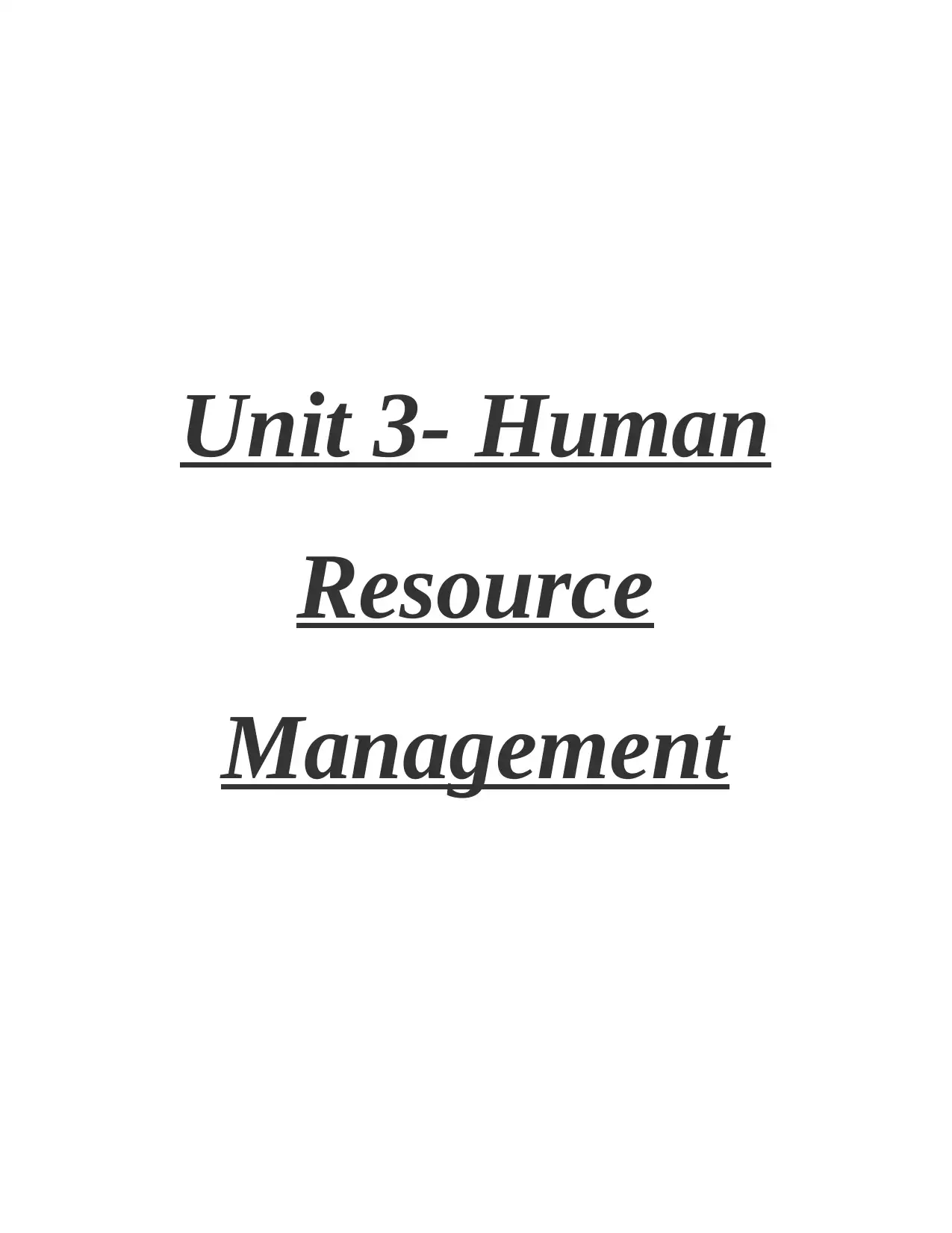
Unit 3- Human
Resource
Management
Resource
Management
Paraphrase This Document
Need a fresh take? Get an instant paraphrase of this document with our AI Paraphraser
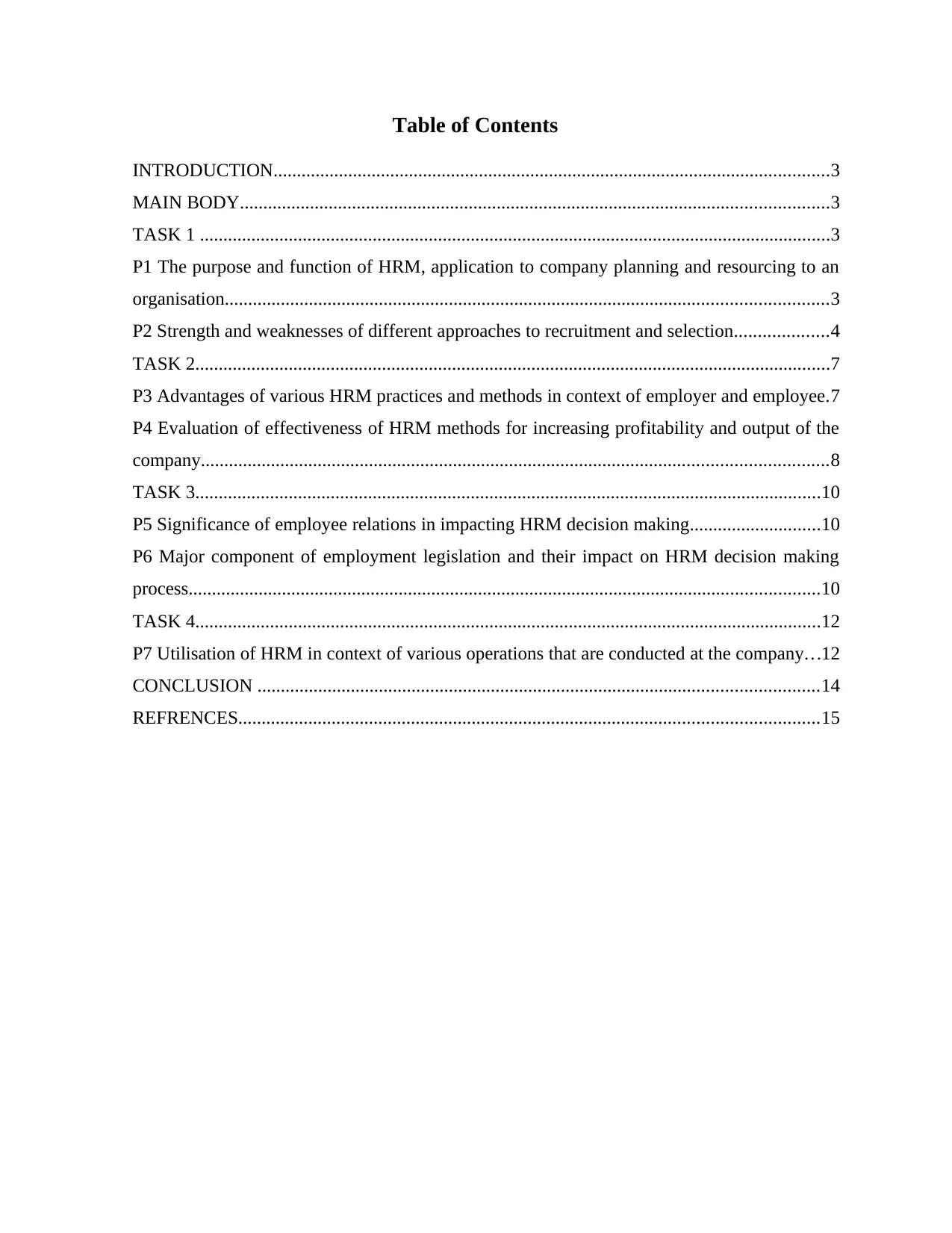
Table of Contents
INTRODUCTION.......................................................................................................................3
MAIN BODY..............................................................................................................................3
TASK 1 .......................................................................................................................................3
P1 The purpose and function of HRM, application to company planning and resourcing to an
organisation.................................................................................................................................3
P2 Strength and weaknesses of different approaches to recruitment and selection....................4
TASK 2........................................................................................................................................7
P3 Advantages of various HRM practices and methods in context of employer and employee.7
P4 Evaluation of effectiveness of HRM methods for increasing profitability and output of the
company......................................................................................................................................8
TASK 3......................................................................................................................................10
P5 Significance of employee relations in impacting HRM decision making............................10
P6 Major component of employment legislation and their impact on HRM decision making
process.......................................................................................................................................10
TASK 4......................................................................................................................................12
P7 Utilisation of HRM in context of various operations that are conducted at the company...12
CONCLUSION ........................................................................................................................14
REFRENCES............................................................................................................................15
INTRODUCTION.......................................................................................................................3
MAIN BODY..............................................................................................................................3
TASK 1 .......................................................................................................................................3
P1 The purpose and function of HRM, application to company planning and resourcing to an
organisation.................................................................................................................................3
P2 Strength and weaknesses of different approaches to recruitment and selection....................4
TASK 2........................................................................................................................................7
P3 Advantages of various HRM practices and methods in context of employer and employee.7
P4 Evaluation of effectiveness of HRM methods for increasing profitability and output of the
company......................................................................................................................................8
TASK 3......................................................................................................................................10
P5 Significance of employee relations in impacting HRM decision making............................10
P6 Major component of employment legislation and their impact on HRM decision making
process.......................................................................................................................................10
TASK 4......................................................................................................................................12
P7 Utilisation of HRM in context of various operations that are conducted at the company...12
CONCLUSION ........................................................................................................................14
REFRENCES............................................................................................................................15
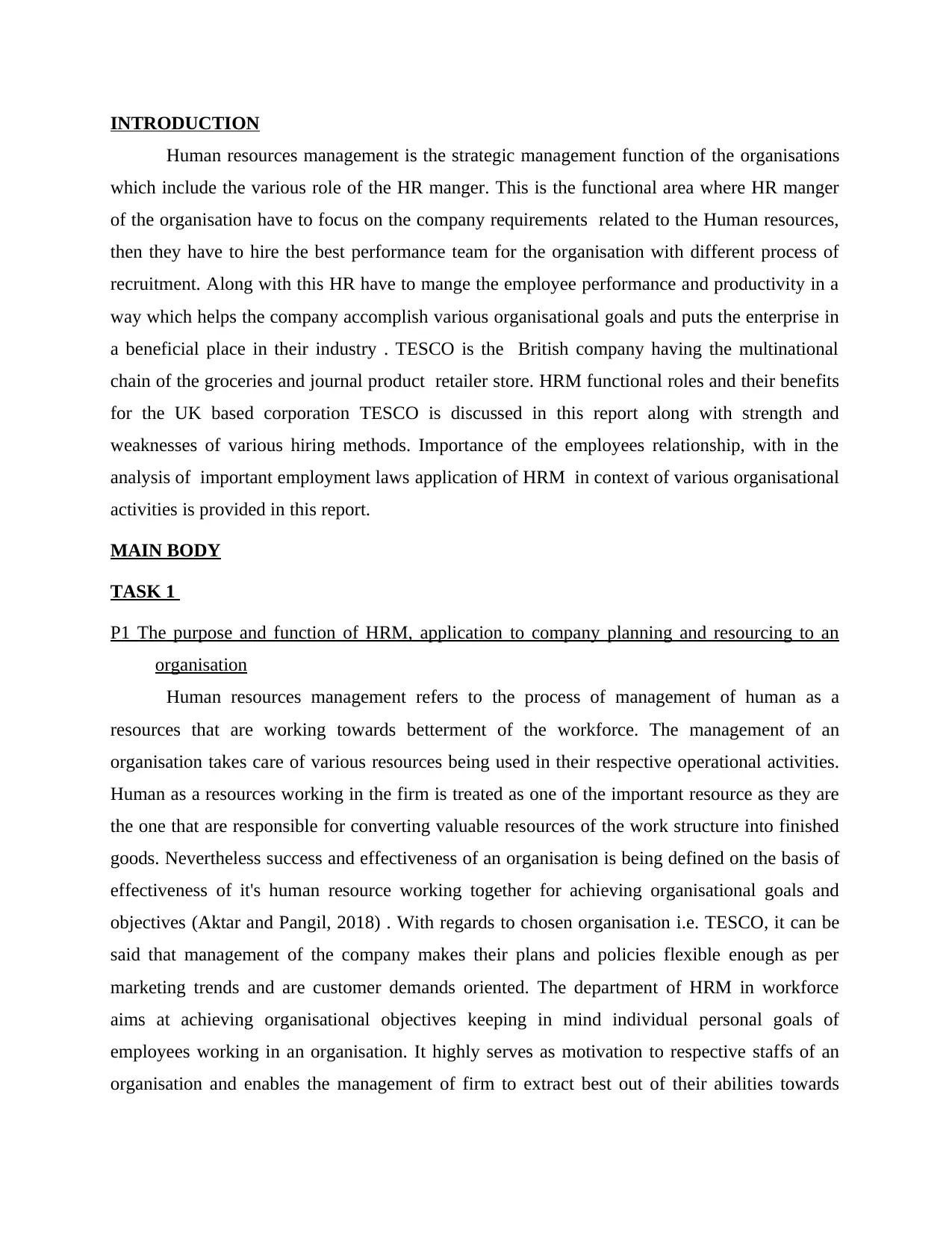
INTRODUCTION
Human resources management is the strategic management function of the organisations
which include the various role of the HR manger. This is the functional area where HR manger
of the organisation have to focus on the company requirements related to the Human resources,
then they have to hire the best performance team for the organisation with different process of
recruitment. Along with this HR have to mange the employee performance and productivity in a
way which helps the company accomplish various organisational goals and puts the enterprise in
a beneficial place in their industry . TESCO is the British company having the multinational
chain of the groceries and journal product retailer store. HRM functional roles and their benefits
for the UK based corporation TESCO is discussed in this report along with strength and
weaknesses of various hiring methods. Importance of the employees relationship, with in the
analysis of important employment laws application of HRM in context of various organisational
activities is provided in this report.
MAIN BODY
TASK 1
P1 The purpose and function of HRM, application to company planning and resourcing to an
organisation
Human resources management refers to the process of management of human as a
resources that are working towards betterment of the workforce. The management of an
organisation takes care of various resources being used in their respective operational activities.
Human as a resources working in the firm is treated as one of the important resource as they are
the one that are responsible for converting valuable resources of the work structure into finished
goods. Nevertheless success and effectiveness of an organisation is being defined on the basis of
effectiveness of it's human resource working together for achieving organisational goals and
objectives (Aktar and Pangil, 2018) . With regards to chosen organisation i.e. TESCO, it can be
said that management of the company makes their plans and policies flexible enough as per
marketing trends and are customer demands oriented. The department of HRM in workforce
aims at achieving organisational objectives keeping in mind individual personal goals of
employees working in an organisation. It highly serves as motivation to respective staffs of an
organisation and enables the management of firm to extract best out of their abilities towards
Human resources management is the strategic management function of the organisations
which include the various role of the HR manger. This is the functional area where HR manger
of the organisation have to focus on the company requirements related to the Human resources,
then they have to hire the best performance team for the organisation with different process of
recruitment. Along with this HR have to mange the employee performance and productivity in a
way which helps the company accomplish various organisational goals and puts the enterprise in
a beneficial place in their industry . TESCO is the British company having the multinational
chain of the groceries and journal product retailer store. HRM functional roles and their benefits
for the UK based corporation TESCO is discussed in this report along with strength and
weaknesses of various hiring methods. Importance of the employees relationship, with in the
analysis of important employment laws application of HRM in context of various organisational
activities is provided in this report.
MAIN BODY
TASK 1
P1 The purpose and function of HRM, application to company planning and resourcing to an
organisation
Human resources management refers to the process of management of human as a
resources that are working towards betterment of the workforce. The management of an
organisation takes care of various resources being used in their respective operational activities.
Human as a resources working in the firm is treated as one of the important resource as they are
the one that are responsible for converting valuable resources of the work structure into finished
goods. Nevertheless success and effectiveness of an organisation is being defined on the basis of
effectiveness of it's human resource working together for achieving organisational goals and
objectives (Aktar and Pangil, 2018) . With regards to chosen organisation i.e. TESCO, it can be
said that management of the company makes their plans and policies flexible enough as per
marketing trends and are customer demands oriented. The department of HRM in workforce
aims at achieving organisational objectives keeping in mind individual personal goals of
employees working in an organisation. It highly serves as motivation to respective staffs of an
organisation and enables the management of firm to extract best out of their abilities towards
⊘ This is a preview!⊘
Do you want full access?
Subscribe today to unlock all pages.

Trusted by 1+ million students worldwide
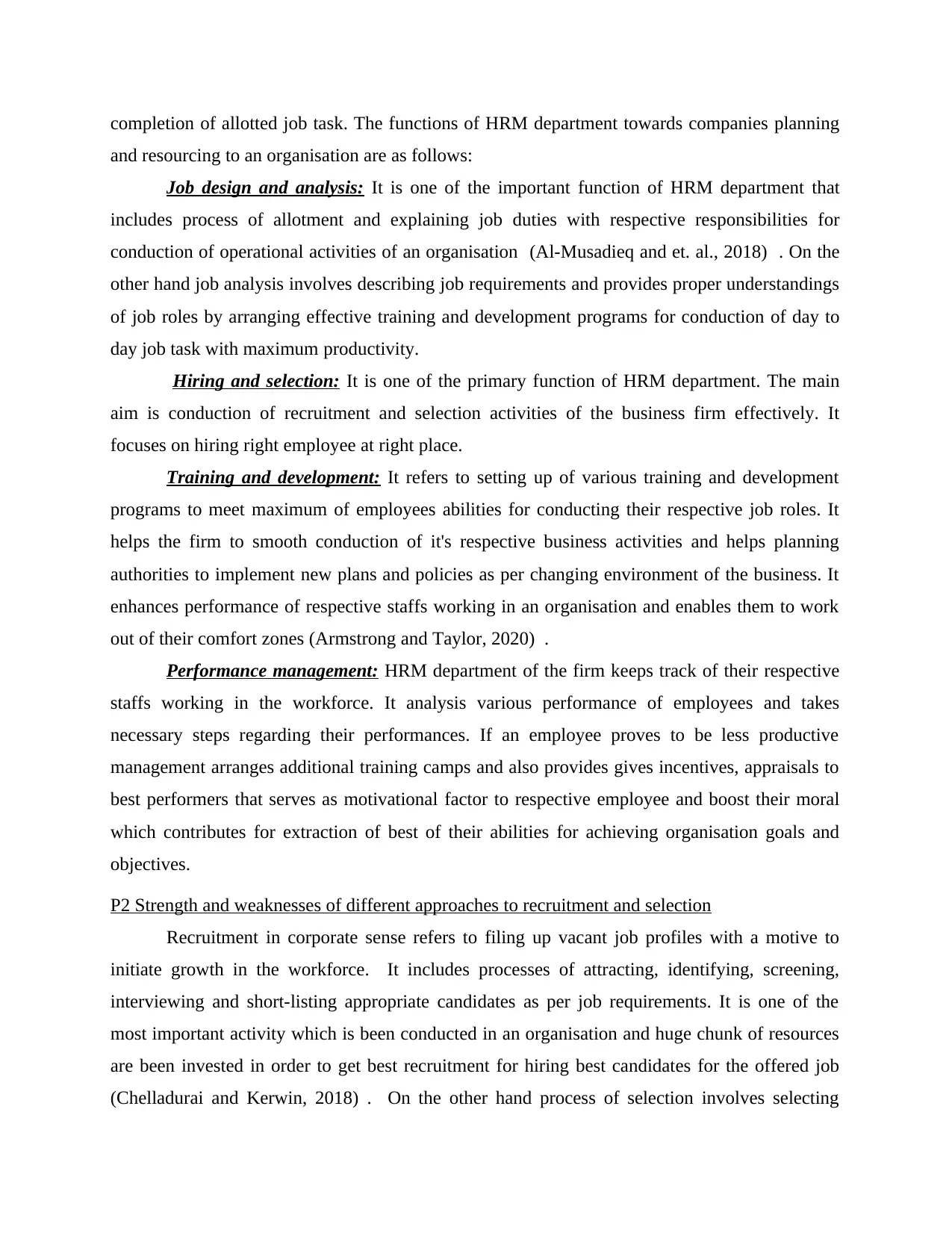
completion of allotted job task. The functions of HRM department towards companies planning
and resourcing to an organisation are as follows:
Job design and analysis: It is one of the important function of HRM department that
includes process of allotment and explaining job duties with respective responsibilities for
conduction of operational activities of an organisation (Al-Musadieq and et. al., 2018) . On the
other hand job analysis involves describing job requirements and provides proper understandings
of job roles by arranging effective training and development programs for conduction of day to
day job task with maximum productivity.
Hiring and selection: It is one of the primary function of HRM department. The main
aim is conduction of recruitment and selection activities of the business firm effectively. It
focuses on hiring right employee at right place.
Training and development: It refers to setting up of various training and development
programs to meet maximum of employees abilities for conducting their respective job roles. It
helps the firm to smooth conduction of it's respective business activities and helps planning
authorities to implement new plans and policies as per changing environment of the business. It
enhances performance of respective staffs working in an organisation and enables them to work
out of their comfort zones (Armstrong and Taylor, 2020) .
Performance management: HRM department of the firm keeps track of their respective
staffs working in the workforce. It analysis various performance of employees and takes
necessary steps regarding their performances. If an employee proves to be less productive
management arranges additional training camps and also provides gives incentives, appraisals to
best performers that serves as motivational factor to respective employee and boost their moral
which contributes for extraction of best of their abilities for achieving organisation goals and
objectives.
P2 Strength and weaknesses of different approaches to recruitment and selection
Recruitment in corporate sense refers to filing up vacant job profiles with a motive to
initiate growth in the workforce. It includes processes of attracting, identifying, screening,
interviewing and short-listing appropriate candidates as per job requirements. It is one of the
most important activity which is been conducted in an organisation and huge chunk of resources
are been invested in order to get best recruitment for hiring best candidates for the offered job
(Chelladurai and Kerwin, 2018) . On the other hand process of selection involves selecting
and resourcing to an organisation are as follows:
Job design and analysis: It is one of the important function of HRM department that
includes process of allotment and explaining job duties with respective responsibilities for
conduction of operational activities of an organisation (Al-Musadieq and et. al., 2018) . On the
other hand job analysis involves describing job requirements and provides proper understandings
of job roles by arranging effective training and development programs for conduction of day to
day job task with maximum productivity.
Hiring and selection: It is one of the primary function of HRM department. The main
aim is conduction of recruitment and selection activities of the business firm effectively. It
focuses on hiring right employee at right place.
Training and development: It refers to setting up of various training and development
programs to meet maximum of employees abilities for conducting their respective job roles. It
helps the firm to smooth conduction of it's respective business activities and helps planning
authorities to implement new plans and policies as per changing environment of the business. It
enhances performance of respective staffs working in an organisation and enables them to work
out of their comfort zones (Armstrong and Taylor, 2020) .
Performance management: HRM department of the firm keeps track of their respective
staffs working in the workforce. It analysis various performance of employees and takes
necessary steps regarding their performances. If an employee proves to be less productive
management arranges additional training camps and also provides gives incentives, appraisals to
best performers that serves as motivational factor to respective employee and boost their moral
which contributes for extraction of best of their abilities for achieving organisation goals and
objectives.
P2 Strength and weaknesses of different approaches to recruitment and selection
Recruitment in corporate sense refers to filing up vacant job profiles with a motive to
initiate growth in the workforce. It includes processes of attracting, identifying, screening,
interviewing and short-listing appropriate candidates as per job requirements. It is one of the
most important activity which is been conducted in an organisation and huge chunk of resources
are been invested in order to get best recruitment for hiring best candidates for the offered job
(Chelladurai and Kerwin, 2018) . On the other hand process of selection involves selecting
Paraphrase This Document
Need a fresh take? Get an instant paraphrase of this document with our AI Paraphraser
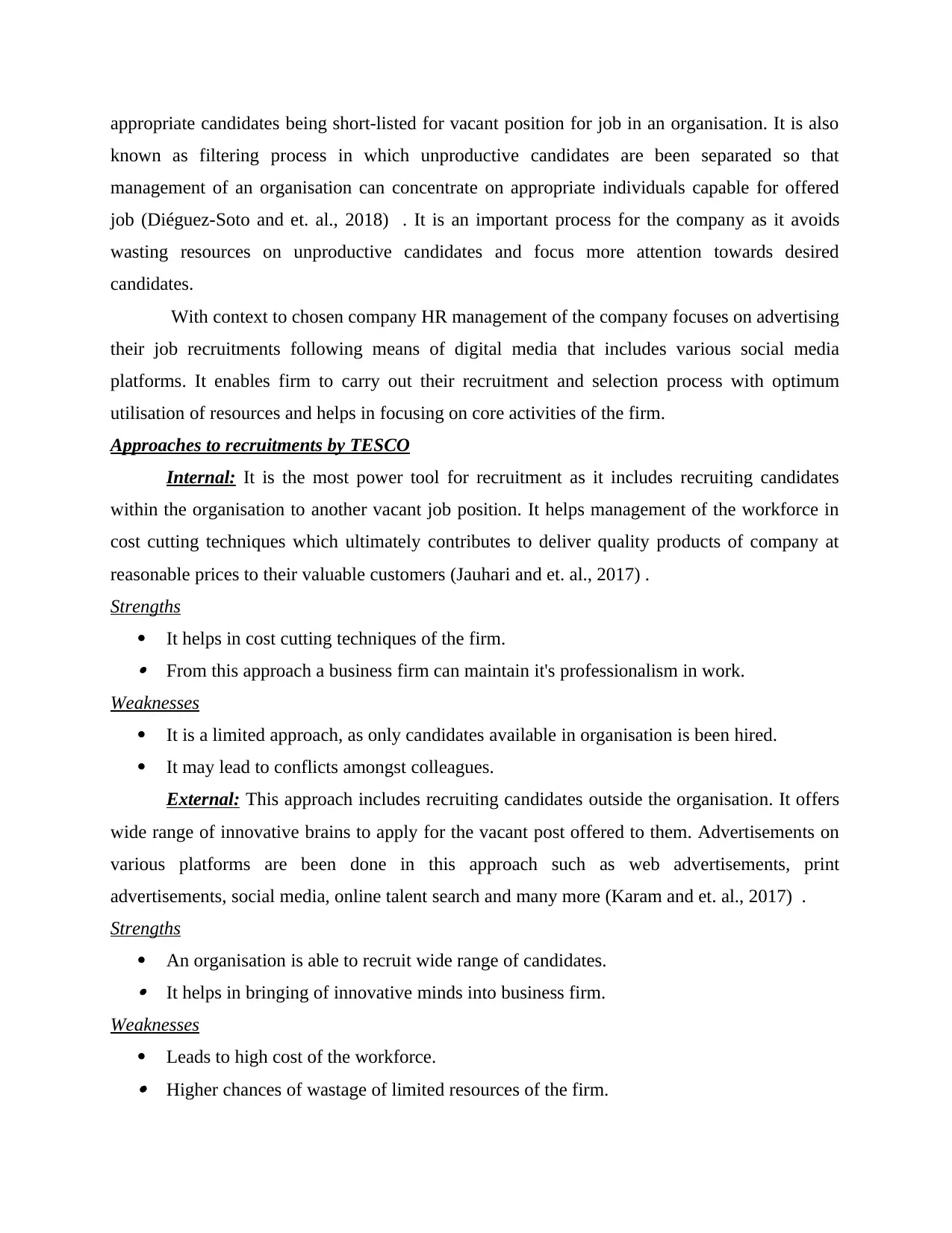
appropriate candidates being short-listed for vacant position for job in an organisation. It is also
known as filtering process in which unproductive candidates are been separated so that
management of an organisation can concentrate on appropriate individuals capable for offered
job (Diéguez-Soto and et. al., 2018) . It is an important process for the company as it avoids
wasting resources on unproductive candidates and focus more attention towards desired
candidates.
With context to chosen company HR management of the company focuses on advertising
their job recruitments following means of digital media that includes various social media
platforms. It enables firm to carry out their recruitment and selection process with optimum
utilisation of resources and helps in focusing on core activities of the firm.
Approaches to recruitments by TESCO
Internal: It is the most power tool for recruitment as it includes recruiting candidates
within the organisation to another vacant job position. It helps management of the workforce in
cost cutting techniques which ultimately contributes to deliver quality products of company at
reasonable prices to their valuable customers (Jauhari and et. al., 2017) .
Strengths
It helps in cost cutting techniques of the firm. From this approach a business firm can maintain it's professionalism in work.
Weaknesses
It is a limited approach, as only candidates available in organisation is been hired.
It may lead to conflicts amongst colleagues.
External: This approach includes recruiting candidates outside the organisation. It offers
wide range of innovative brains to apply for the vacant post offered to them. Advertisements on
various platforms are been done in this approach such as web advertisements, print
advertisements, social media, online talent search and many more (Karam and et. al., 2017) .
Strengths
An organisation is able to recruit wide range of candidates. It helps in bringing of innovative minds into business firm.
Weaknesses
Leads to high cost of the workforce. Higher chances of wastage of limited resources of the firm.
known as filtering process in which unproductive candidates are been separated so that
management of an organisation can concentrate on appropriate individuals capable for offered
job (Diéguez-Soto and et. al., 2018) . It is an important process for the company as it avoids
wasting resources on unproductive candidates and focus more attention towards desired
candidates.
With context to chosen company HR management of the company focuses on advertising
their job recruitments following means of digital media that includes various social media
platforms. It enables firm to carry out their recruitment and selection process with optimum
utilisation of resources and helps in focusing on core activities of the firm.
Approaches to recruitments by TESCO
Internal: It is the most power tool for recruitment as it includes recruiting candidates
within the organisation to another vacant job position. It helps management of the workforce in
cost cutting techniques which ultimately contributes to deliver quality products of company at
reasonable prices to their valuable customers (Jauhari and et. al., 2017) .
Strengths
It helps in cost cutting techniques of the firm. From this approach a business firm can maintain it's professionalism in work.
Weaknesses
It is a limited approach, as only candidates available in organisation is been hired.
It may lead to conflicts amongst colleagues.
External: This approach includes recruiting candidates outside the organisation. It offers
wide range of innovative brains to apply for the vacant post offered to them. Advertisements on
various platforms are been done in this approach such as web advertisements, print
advertisements, social media, online talent search and many more (Karam and et. al., 2017) .
Strengths
An organisation is able to recruit wide range of candidates. It helps in bringing of innovative minds into business firm.
Weaknesses
Leads to high cost of the workforce. Higher chances of wastage of limited resources of the firm.
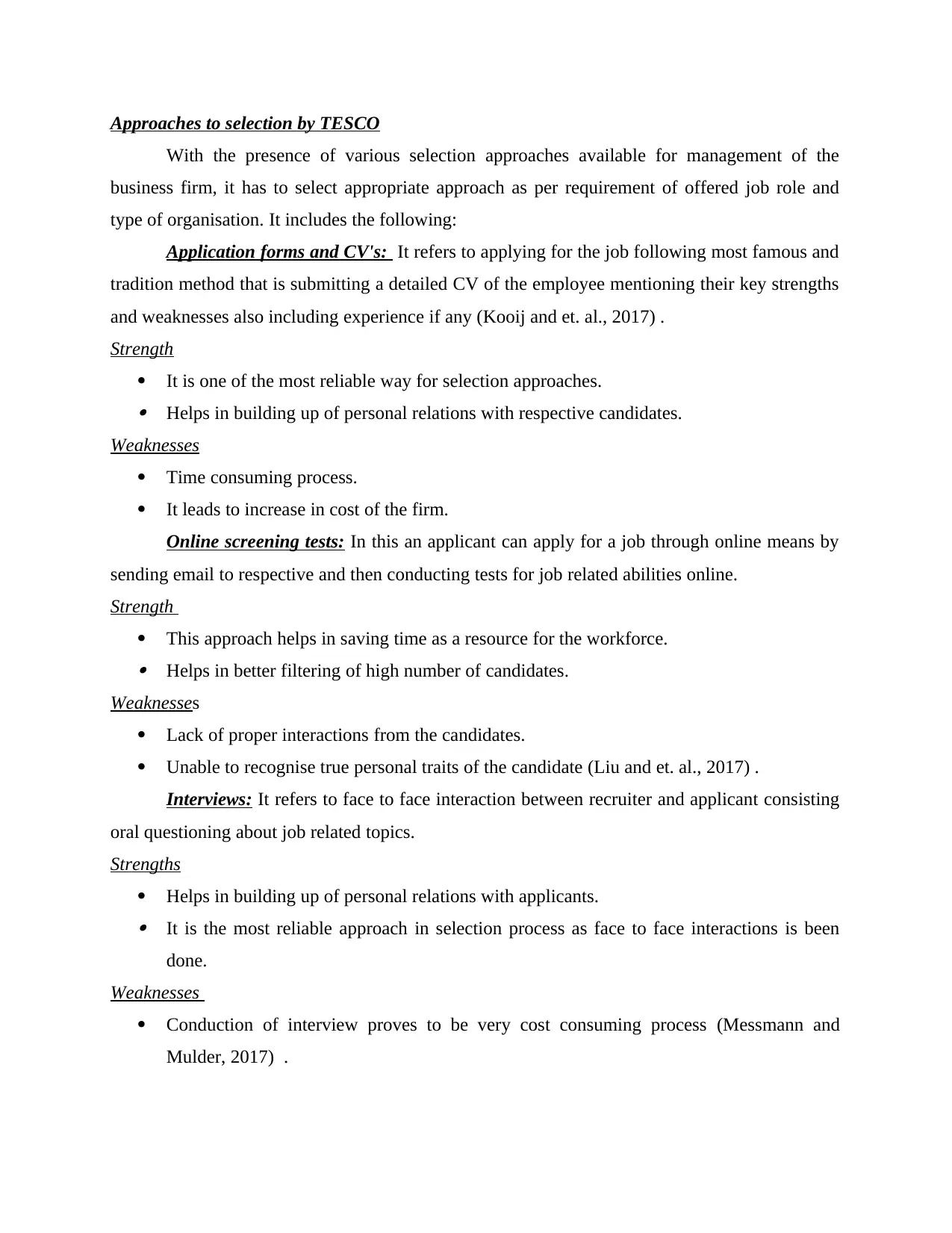
Approaches to selection by TESCO
With the presence of various selection approaches available for management of the
business firm, it has to select appropriate approach as per requirement of offered job role and
type of organisation. It includes the following:
Application forms and CV's: It refers to applying for the job following most famous and
tradition method that is submitting a detailed CV of the employee mentioning their key strengths
and weaknesses also including experience if any (Kooij and et. al., 2017) .
Strength
It is one of the most reliable way for selection approaches. Helps in building up of personal relations with respective candidates.
Weaknesses
Time consuming process.
It leads to increase in cost of the firm.
Online screening tests: In this an applicant can apply for a job through online means by
sending email to respective and then conducting tests for job related abilities online.
Strength
This approach helps in saving time as a resource for the workforce. Helps in better filtering of high number of candidates.
Weaknesses
Lack of proper interactions from the candidates.
Unable to recognise true personal traits of the candidate (Liu and et. al., 2017) .
Interviews: It refers to face to face interaction between recruiter and applicant consisting
oral questioning about job related topics.
Strengths
Helps in building up of personal relations with applicants. It is the most reliable approach in selection process as face to face interactions is been
done.
Weaknesses
Conduction of interview proves to be very cost consuming process (Messmann and
Mulder, 2017) .
With the presence of various selection approaches available for management of the
business firm, it has to select appropriate approach as per requirement of offered job role and
type of organisation. It includes the following:
Application forms and CV's: It refers to applying for the job following most famous and
tradition method that is submitting a detailed CV of the employee mentioning their key strengths
and weaknesses also including experience if any (Kooij and et. al., 2017) .
Strength
It is one of the most reliable way for selection approaches. Helps in building up of personal relations with respective candidates.
Weaknesses
Time consuming process.
It leads to increase in cost of the firm.
Online screening tests: In this an applicant can apply for a job through online means by
sending email to respective and then conducting tests for job related abilities online.
Strength
This approach helps in saving time as a resource for the workforce. Helps in better filtering of high number of candidates.
Weaknesses
Lack of proper interactions from the candidates.
Unable to recognise true personal traits of the candidate (Liu and et. al., 2017) .
Interviews: It refers to face to face interaction between recruiter and applicant consisting
oral questioning about job related topics.
Strengths
Helps in building up of personal relations with applicants. It is the most reliable approach in selection process as face to face interactions is been
done.
Weaknesses
Conduction of interview proves to be very cost consuming process (Messmann and
Mulder, 2017) .
⊘ This is a preview!⊘
Do you want full access?
Subscribe today to unlock all pages.

Trusted by 1+ million students worldwide
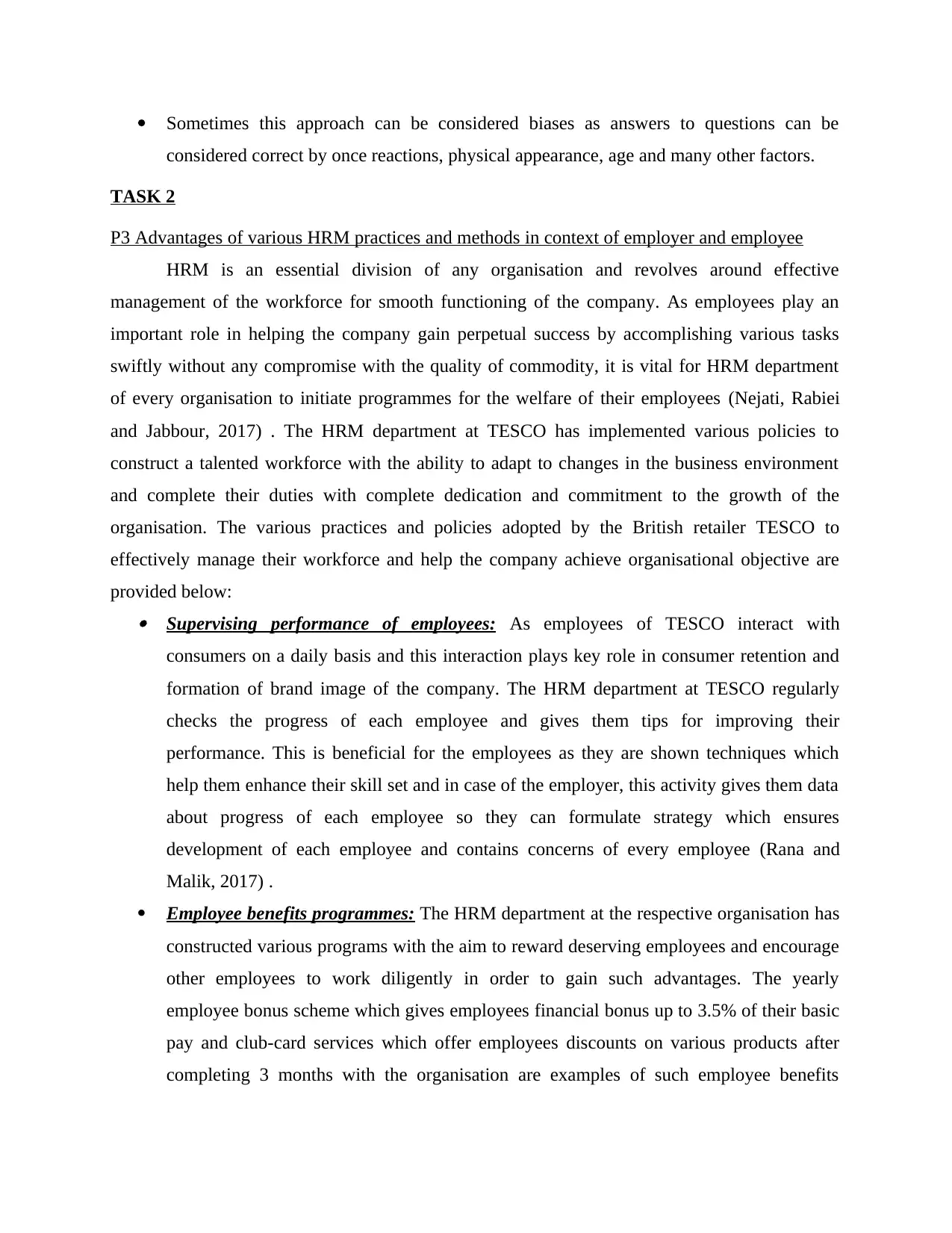
Sometimes this approach can be considered biases as answers to questions can be
considered correct by once reactions, physical appearance, age and many other factors.
TASK 2
P3 Advantages of various HRM practices and methods in context of employer and employee
HRM is an essential division of any organisation and revolves around effective
management of the workforce for smooth functioning of the company. As employees play an
important role in helping the company gain perpetual success by accomplishing various tasks
swiftly without any compromise with the quality of commodity, it is vital for HRM department
of every organisation to initiate programmes for the welfare of their employees (Nejati, Rabiei
and Jabbour, 2017) . The HRM department at TESCO has implemented various policies to
construct a talented workforce with the ability to adapt to changes in the business environment
and complete their duties with complete dedication and commitment to the growth of the
organisation. The various practices and policies adopted by the British retailer TESCO to
effectively manage their workforce and help the company achieve organisational objective are
provided below: Supervising performance of employees: As employees of TESCO interact with
consumers on a daily basis and this interaction plays key role in consumer retention and
formation of brand image of the company. The HRM department at TESCO regularly
checks the progress of each employee and gives them tips for improving their
performance. This is beneficial for the employees as they are shown techniques which
help them enhance their skill set and in case of the employer, this activity gives them data
about progress of each employee so they can formulate strategy which ensures
development of each employee and contains concerns of every employee (Rana and
Malik, 2017) .
Employee benefits programmes: The HRM department at the respective organisation has
constructed various programs with the aim to reward deserving employees and encourage
other employees to work diligently in order to gain such advantages. The yearly
employee bonus scheme which gives employees financial bonus up to 3.5% of their basic
pay and club-card services which offer employees discounts on various products after
completing 3 months with the organisation are examples of such employee benefits
considered correct by once reactions, physical appearance, age and many other factors.
TASK 2
P3 Advantages of various HRM practices and methods in context of employer and employee
HRM is an essential division of any organisation and revolves around effective
management of the workforce for smooth functioning of the company. As employees play an
important role in helping the company gain perpetual success by accomplishing various tasks
swiftly without any compromise with the quality of commodity, it is vital for HRM department
of every organisation to initiate programmes for the welfare of their employees (Nejati, Rabiei
and Jabbour, 2017) . The HRM department at TESCO has implemented various policies to
construct a talented workforce with the ability to adapt to changes in the business environment
and complete their duties with complete dedication and commitment to the growth of the
organisation. The various practices and policies adopted by the British retailer TESCO to
effectively manage their workforce and help the company achieve organisational objective are
provided below: Supervising performance of employees: As employees of TESCO interact with
consumers on a daily basis and this interaction plays key role in consumer retention and
formation of brand image of the company. The HRM department at TESCO regularly
checks the progress of each employee and gives them tips for improving their
performance. This is beneficial for the employees as they are shown techniques which
help them enhance their skill set and in case of the employer, this activity gives them data
about progress of each employee so they can formulate strategy which ensures
development of each employee and contains concerns of every employee (Rana and
Malik, 2017) .
Employee benefits programmes: The HRM department at the respective organisation has
constructed various programs with the aim to reward deserving employees and encourage
other employees to work diligently in order to gain such advantages. The yearly
employee bonus scheme which gives employees financial bonus up to 3.5% of their basic
pay and club-card services which offer employees discounts on various products after
completing 3 months with the organisation are examples of such employee benefits
Paraphrase This Document
Need a fresh take? Get an instant paraphrase of this document with our AI Paraphraser
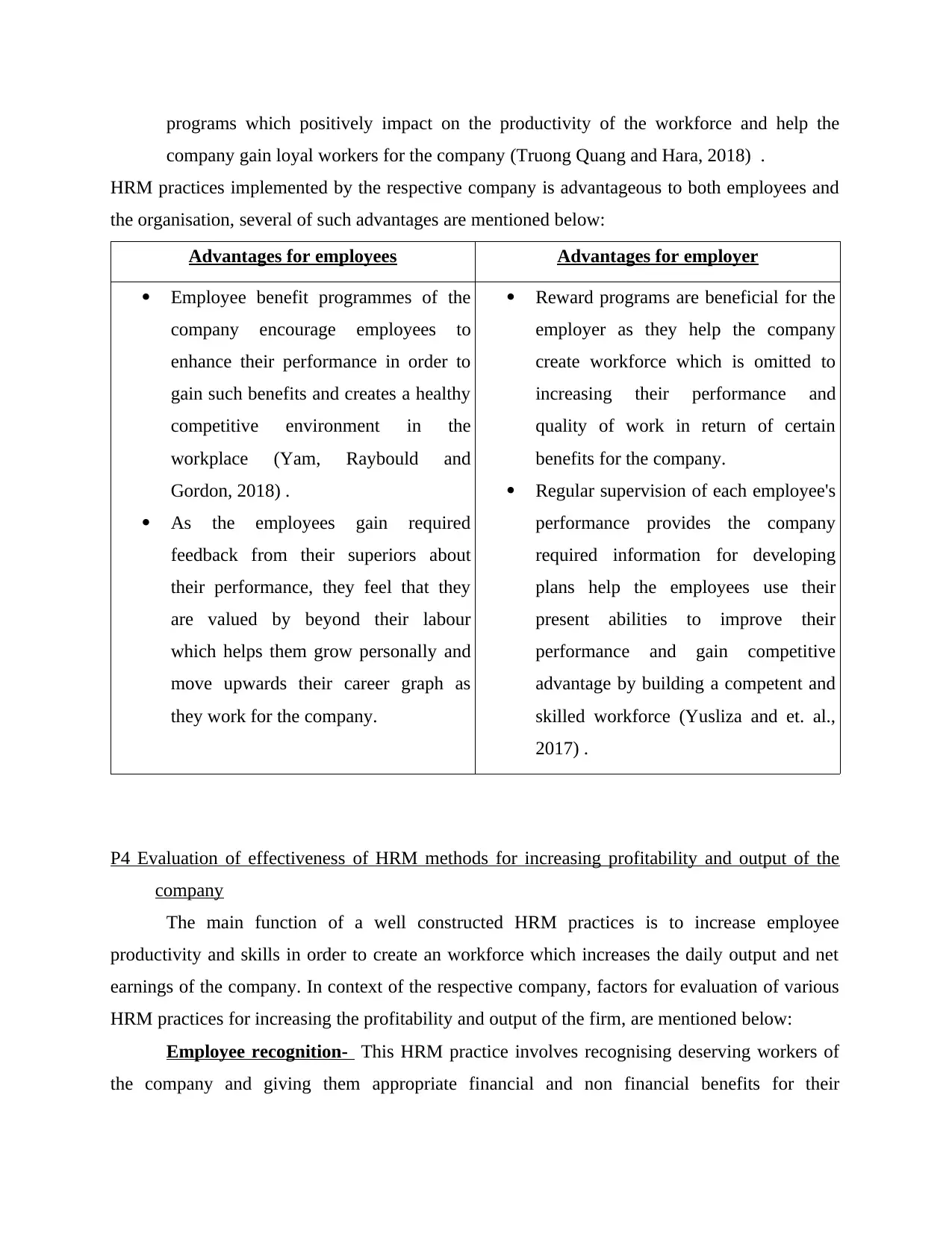
programs which positively impact on the productivity of the workforce and help the
company gain loyal workers for the company (Truong Quang and Hara, 2018) .
HRM practices implemented by the respective company is advantageous to both employees and
the organisation, several of such advantages are mentioned below:
Advantages for employees Advantages for employer
Employee benefit programmes of the
company encourage employees to
enhance their performance in order to
gain such benefits and creates a healthy
competitive environment in the
workplace (Yam, Raybould and
Gordon, 2018) .
As the employees gain required
feedback from their superiors about
their performance, they feel that they
are valued by beyond their labour
which helps them grow personally and
move upwards their career graph as
they work for the company.
Reward programs are beneficial for the
employer as they help the company
create workforce which is omitted to
increasing their performance and
quality of work in return of certain
benefits for the company.
Regular supervision of each employee's
performance provides the company
required information for developing
plans help the employees use their
present abilities to improve their
performance and gain competitive
advantage by building a competent and
skilled workforce (Yusliza and et. al.,
2017) .
P4 Evaluation of effectiveness of HRM methods for increasing profitability and output of the
company
The main function of a well constructed HRM practices is to increase employee
productivity and skills in order to create an workforce which increases the daily output and net
earnings of the company. In context of the respective company, factors for evaluation of various
HRM practices for increasing the profitability and output of the firm, are mentioned below:
Employee recognition- This HRM practice involves recognising deserving workers of
the company and giving them appropriate financial and non financial benefits for their
company gain loyal workers for the company (Truong Quang and Hara, 2018) .
HRM practices implemented by the respective company is advantageous to both employees and
the organisation, several of such advantages are mentioned below:
Advantages for employees Advantages for employer
Employee benefit programmes of the
company encourage employees to
enhance their performance in order to
gain such benefits and creates a healthy
competitive environment in the
workplace (Yam, Raybould and
Gordon, 2018) .
As the employees gain required
feedback from their superiors about
their performance, they feel that they
are valued by beyond their labour
which helps them grow personally and
move upwards their career graph as
they work for the company.
Reward programs are beneficial for the
employer as they help the company
create workforce which is omitted to
increasing their performance and
quality of work in return of certain
benefits for the company.
Regular supervision of each employee's
performance provides the company
required information for developing
plans help the employees use their
present abilities to improve their
performance and gain competitive
advantage by building a competent and
skilled workforce (Yusliza and et. al.,
2017) .
P4 Evaluation of effectiveness of HRM methods for increasing profitability and output of the
company
The main function of a well constructed HRM practices is to increase employee
productivity and skills in order to create an workforce which increases the daily output and net
earnings of the company. In context of the respective company, factors for evaluation of various
HRM practices for increasing the profitability and output of the firm, are mentioned below:
Employee recognition- This HRM practice involves recognising deserving workers of
the company and giving them appropriate financial and non financial benefits for their
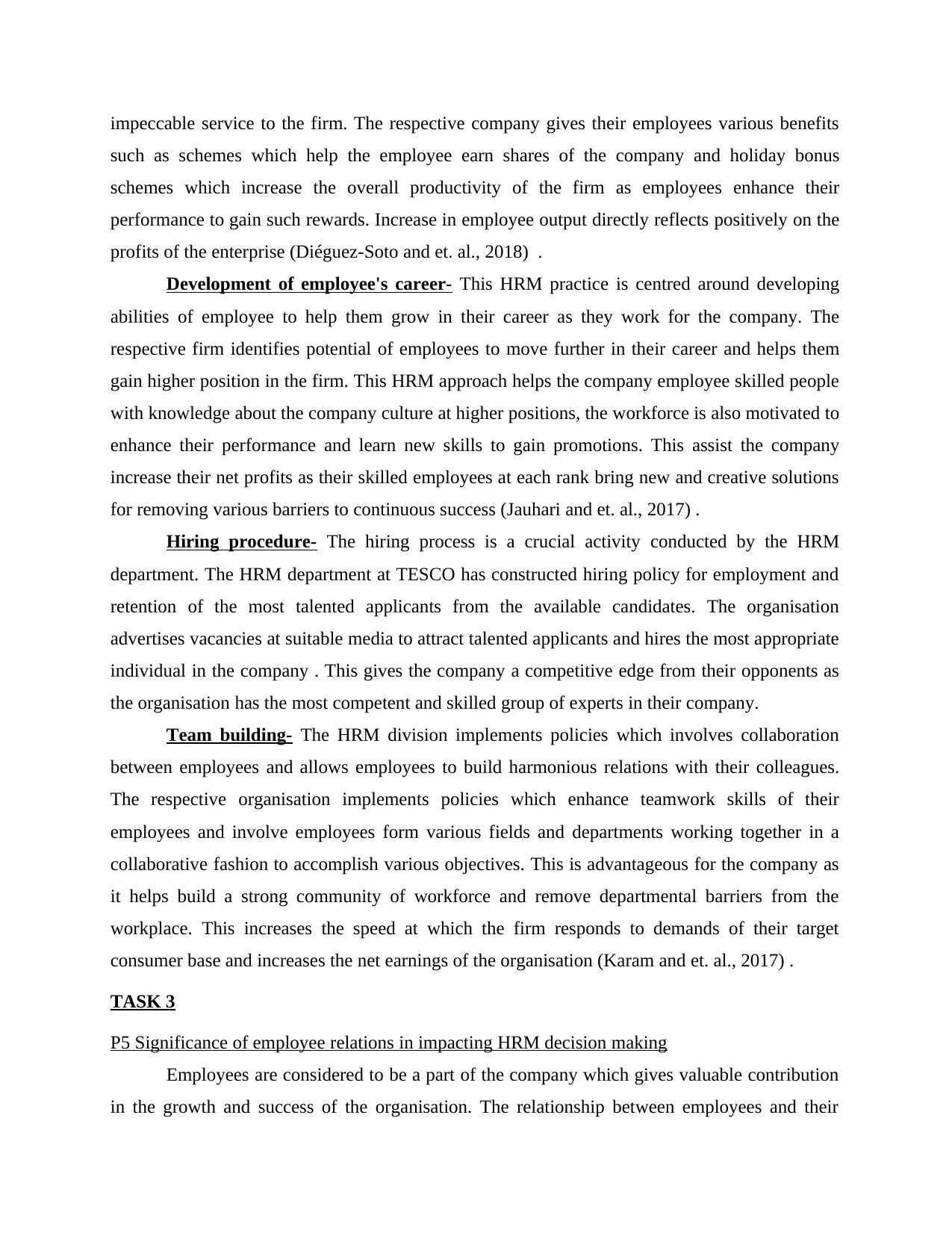
impeccable service to the firm. The respective company gives their employees various benefits
such as schemes which help the employee earn shares of the company and holiday bonus
schemes which increase the overall productivity of the firm as employees enhance their
performance to gain such rewards. Increase in employee output directly reflects positively on the
profits of the enterprise (Diéguez-Soto and et. al., 2018) .
Development of employee's career- This HRM practice is centred around developing
abilities of employee to help them grow in their career as they work for the company. The
respective firm identifies potential of employees to move further in their career and helps them
gain higher position in the firm. This HRM approach helps the company employee skilled people
with knowledge about the company culture at higher positions, the workforce is also motivated to
enhance their performance and learn new skills to gain promotions. This assist the company
increase their net profits as their skilled employees at each rank bring new and creative solutions
for removing various barriers to continuous success (Jauhari and et. al., 2017) .
Hiring procedure- The hiring process is a crucial activity conducted by the HRM
department. The HRM department at TESCO has constructed hiring policy for employment and
retention of the most talented applicants from the available candidates. The organisation
advertises vacancies at suitable media to attract talented applicants and hires the most appropriate
individual in the company . This gives the company a competitive edge from their opponents as
the organisation has the most competent and skilled group of experts in their company.
Team building- The HRM division implements policies which involves collaboration
between employees and allows employees to build harmonious relations with their colleagues.
The respective organisation implements policies which enhance teamwork skills of their
employees and involve employees form various fields and departments working together in a
collaborative fashion to accomplish various objectives. This is advantageous for the company as
it helps build a strong community of workforce and remove departmental barriers from the
workplace. This increases the speed at which the firm responds to demands of their target
consumer base and increases the net earnings of the organisation (Karam and et. al., 2017) .
TASK 3
P5 Significance of employee relations in impacting HRM decision making
Employees are considered to be a part of the company which gives valuable contribution
in the growth and success of the organisation. The relationship between employees and their
such as schemes which help the employee earn shares of the company and holiday bonus
schemes which increase the overall productivity of the firm as employees enhance their
performance to gain such rewards. Increase in employee output directly reflects positively on the
profits of the enterprise (Diéguez-Soto and et. al., 2018) .
Development of employee's career- This HRM practice is centred around developing
abilities of employee to help them grow in their career as they work for the company. The
respective firm identifies potential of employees to move further in their career and helps them
gain higher position in the firm. This HRM approach helps the company employee skilled people
with knowledge about the company culture at higher positions, the workforce is also motivated to
enhance their performance and learn new skills to gain promotions. This assist the company
increase their net profits as their skilled employees at each rank bring new and creative solutions
for removing various barriers to continuous success (Jauhari and et. al., 2017) .
Hiring procedure- The hiring process is a crucial activity conducted by the HRM
department. The HRM department at TESCO has constructed hiring policy for employment and
retention of the most talented applicants from the available candidates. The organisation
advertises vacancies at suitable media to attract talented applicants and hires the most appropriate
individual in the company . This gives the company a competitive edge from their opponents as
the organisation has the most competent and skilled group of experts in their company.
Team building- The HRM division implements policies which involves collaboration
between employees and allows employees to build harmonious relations with their colleagues.
The respective organisation implements policies which enhance teamwork skills of their
employees and involve employees form various fields and departments working together in a
collaborative fashion to accomplish various objectives. This is advantageous for the company as
it helps build a strong community of workforce and remove departmental barriers from the
workplace. This increases the speed at which the firm responds to demands of their target
consumer base and increases the net earnings of the organisation (Karam and et. al., 2017) .
TASK 3
P5 Significance of employee relations in impacting HRM decision making
Employees are considered to be a part of the company which gives valuable contribution
in the growth and success of the organisation. The relationship between employees and their
⊘ This is a preview!⊘
Do you want full access?
Subscribe today to unlock all pages.

Trusted by 1+ million students worldwide
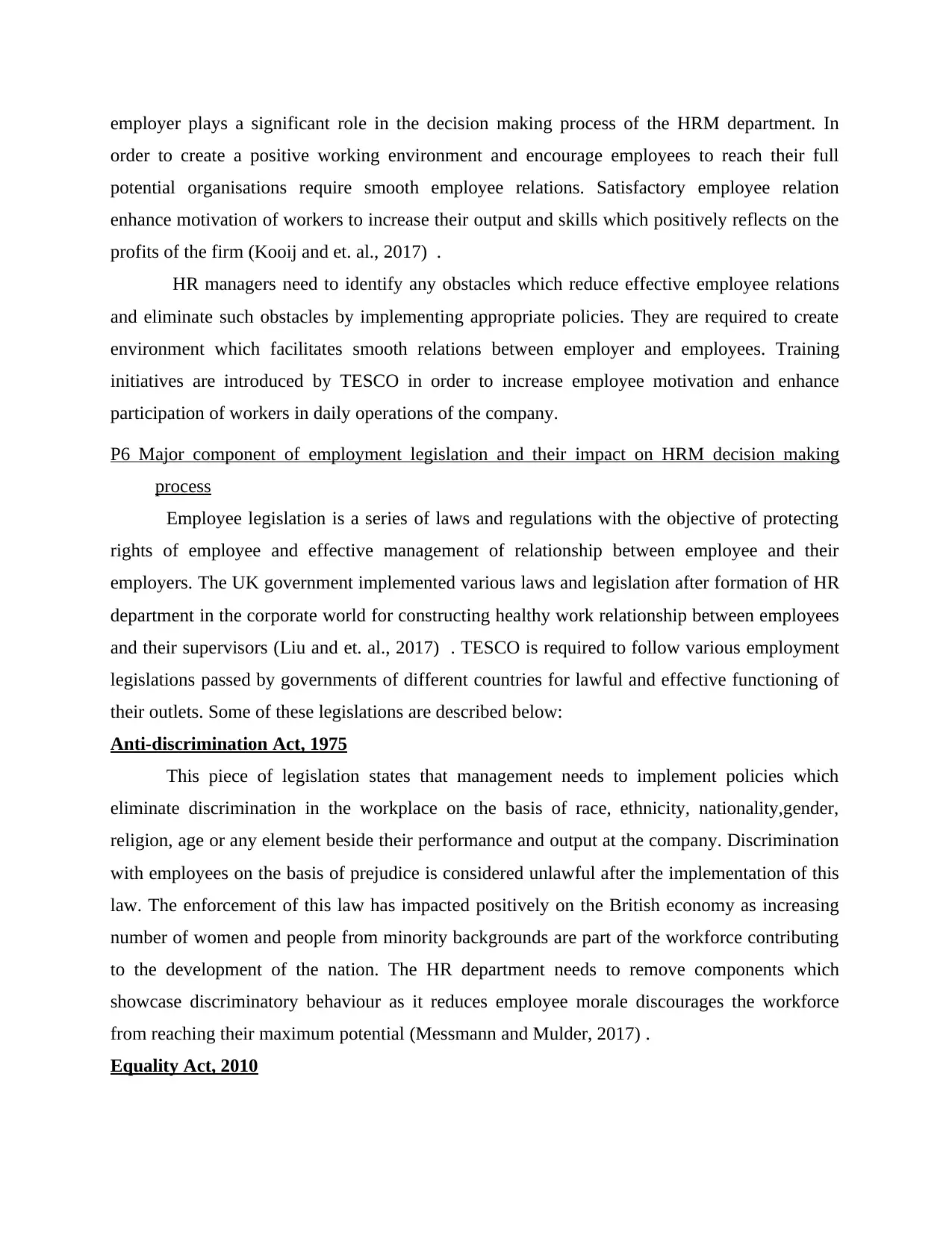
employer plays a significant role in the decision making process of the HRM department. In
order to create a positive working environment and encourage employees to reach their full
potential organisations require smooth employee relations. Satisfactory employee relation
enhance motivation of workers to increase their output and skills which positively reflects on the
profits of the firm (Kooij and et. al., 2017) .
HR managers need to identify any obstacles which reduce effective employee relations
and eliminate such obstacles by implementing appropriate policies. They are required to create
environment which facilitates smooth relations between employer and employees. Training
initiatives are introduced by TESCO in order to increase employee motivation and enhance
participation of workers in daily operations of the company.
P6 Major component of employment legislation and their impact on HRM decision making
process
Employee legislation is a series of laws and regulations with the objective of protecting
rights of employee and effective management of relationship between employee and their
employers. The UK government implemented various laws and legislation after formation of HR
department in the corporate world for constructing healthy work relationship between employees
and their supervisors (Liu and et. al., 2017) . TESCO is required to follow various employment
legislations passed by governments of different countries for lawful and effective functioning of
their outlets. Some of these legislations are described below:
Anti-discrimination Act, 1975
This piece of legislation states that management needs to implement policies which
eliminate discrimination in the workplace on the basis of race, ethnicity, nationality,gender,
religion, age or any element beside their performance and output at the company. Discrimination
with employees on the basis of prejudice is considered unlawful after the implementation of this
law. The enforcement of this law has impacted positively on the British economy as increasing
number of women and people from minority backgrounds are part of the workforce contributing
to the development of the nation. The HR department needs to remove components which
showcase discriminatory behaviour as it reduces employee morale discourages the workforce
from reaching their maximum potential (Messmann and Mulder, 2017) .
Equality Act, 2010
order to create a positive working environment and encourage employees to reach their full
potential organisations require smooth employee relations. Satisfactory employee relation
enhance motivation of workers to increase their output and skills which positively reflects on the
profits of the firm (Kooij and et. al., 2017) .
HR managers need to identify any obstacles which reduce effective employee relations
and eliminate such obstacles by implementing appropriate policies. They are required to create
environment which facilitates smooth relations between employer and employees. Training
initiatives are introduced by TESCO in order to increase employee motivation and enhance
participation of workers in daily operations of the company.
P6 Major component of employment legislation and their impact on HRM decision making
process
Employee legislation is a series of laws and regulations with the objective of protecting
rights of employee and effective management of relationship between employee and their
employers. The UK government implemented various laws and legislation after formation of HR
department in the corporate world for constructing healthy work relationship between employees
and their supervisors (Liu and et. al., 2017) . TESCO is required to follow various employment
legislations passed by governments of different countries for lawful and effective functioning of
their outlets. Some of these legislations are described below:
Anti-discrimination Act, 1975
This piece of legislation states that management needs to implement policies which
eliminate discrimination in the workplace on the basis of race, ethnicity, nationality,gender,
religion, age or any element beside their performance and output at the company. Discrimination
with employees on the basis of prejudice is considered unlawful after the implementation of this
law. The enforcement of this law has impacted positively on the British economy as increasing
number of women and people from minority backgrounds are part of the workforce contributing
to the development of the nation. The HR department needs to remove components which
showcase discriminatory behaviour as it reduces employee morale discourages the workforce
from reaching their maximum potential (Messmann and Mulder, 2017) .
Equality Act, 2010
Paraphrase This Document
Need a fresh take? Get an instant paraphrase of this document with our AI Paraphraser
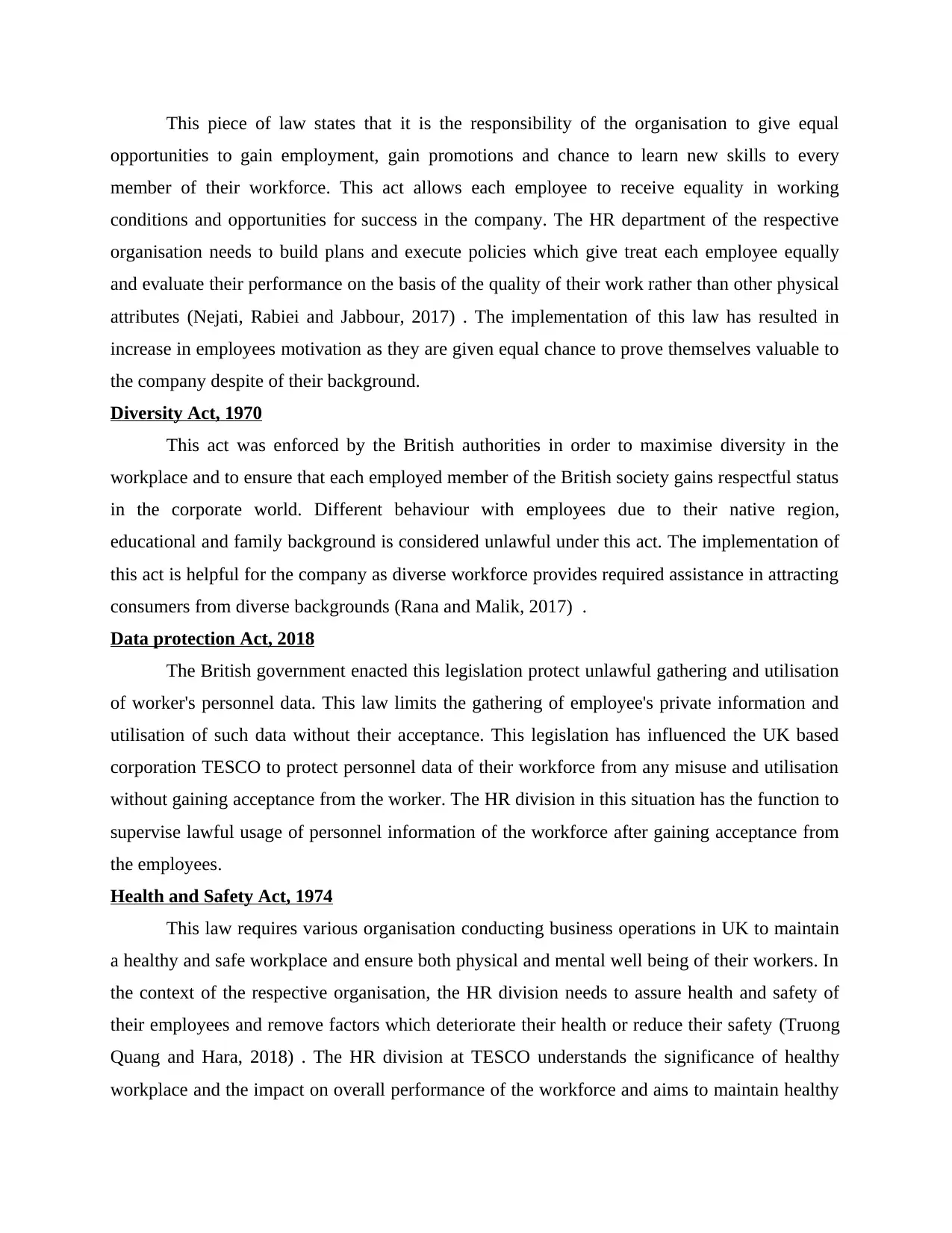
This piece of law states that it is the responsibility of the organisation to give equal
opportunities to gain employment, gain promotions and chance to learn new skills to every
member of their workforce. This act allows each employee to receive equality in working
conditions and opportunities for success in the company. The HR department of the respective
organisation needs to build plans and execute policies which give treat each employee equally
and evaluate their performance on the basis of the quality of their work rather than other physical
attributes (Nejati, Rabiei and Jabbour, 2017) . The implementation of this law has resulted in
increase in employees motivation as they are given equal chance to prove themselves valuable to
the company despite of their background.
Diversity Act, 1970
This act was enforced by the British authorities in order to maximise diversity in the
workplace and to ensure that each employed member of the British society gains respectful status
in the corporate world. Different behaviour with employees due to their native region,
educational and family background is considered unlawful under this act. The implementation of
this act is helpful for the company as diverse workforce provides required assistance in attracting
consumers from diverse backgrounds (Rana and Malik, 2017) .
Data protection Act, 2018
The British government enacted this legislation protect unlawful gathering and utilisation
of worker's personnel data. This law limits the gathering of employee's private information and
utilisation of such data without their acceptance. This legislation has influenced the UK based
corporation TESCO to protect personnel data of their workforce from any misuse and utilisation
without gaining acceptance from the worker. The HR division in this situation has the function to
supervise lawful usage of personnel information of the workforce after gaining acceptance from
the employees.
Health and Safety Act, 1974
This law requires various organisation conducting business operations in UK to maintain
a healthy and safe workplace and ensure both physical and mental well being of their workers. In
the context of the respective organisation, the HR division needs to assure health and safety of
their employees and remove factors which deteriorate their health or reduce their safety (Truong
Quang and Hara, 2018) . The HR division at TESCO understands the significance of healthy
workplace and the impact on overall performance of the workforce and aims to maintain healthy
opportunities to gain employment, gain promotions and chance to learn new skills to every
member of their workforce. This act allows each employee to receive equality in working
conditions and opportunities for success in the company. The HR department of the respective
organisation needs to build plans and execute policies which give treat each employee equally
and evaluate their performance on the basis of the quality of their work rather than other physical
attributes (Nejati, Rabiei and Jabbour, 2017) . The implementation of this law has resulted in
increase in employees motivation as they are given equal chance to prove themselves valuable to
the company despite of their background.
Diversity Act, 1970
This act was enforced by the British authorities in order to maximise diversity in the
workplace and to ensure that each employed member of the British society gains respectful status
in the corporate world. Different behaviour with employees due to their native region,
educational and family background is considered unlawful under this act. The implementation of
this act is helpful for the company as diverse workforce provides required assistance in attracting
consumers from diverse backgrounds (Rana and Malik, 2017) .
Data protection Act, 2018
The British government enacted this legislation protect unlawful gathering and utilisation
of worker's personnel data. This law limits the gathering of employee's private information and
utilisation of such data without their acceptance. This legislation has influenced the UK based
corporation TESCO to protect personnel data of their workforce from any misuse and utilisation
without gaining acceptance from the worker. The HR division in this situation has the function to
supervise lawful usage of personnel information of the workforce after gaining acceptance from
the employees.
Health and Safety Act, 1974
This law requires various organisation conducting business operations in UK to maintain
a healthy and safe workplace and ensure both physical and mental well being of their workers. In
the context of the respective organisation, the HR division needs to assure health and safety of
their employees and remove factors which deteriorate their health or reduce their safety (Truong
Quang and Hara, 2018) . The HR division at TESCO understands the significance of healthy
workplace and the impact on overall performance of the workforce and aims to maintain healthy
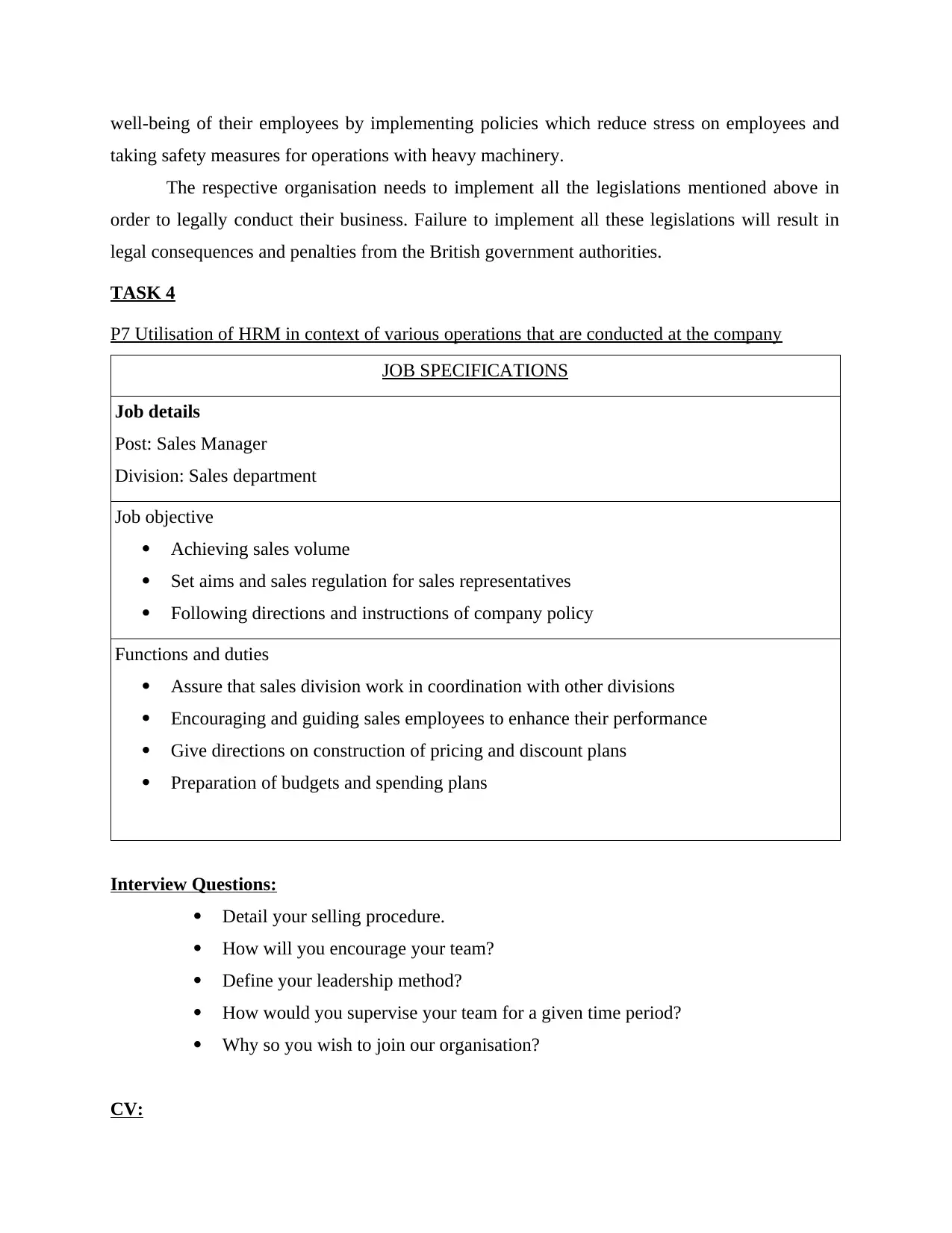
well-being of their employees by implementing policies which reduce stress on employees and
taking safety measures for operations with heavy machinery.
The respective organisation needs to implement all the legislations mentioned above in
order to legally conduct their business. Failure to implement all these legislations will result in
legal consequences and penalties from the British government authorities.
TASK 4
P7 Utilisation of HRM in context of various operations that are conducted at the company
JOB SPECIFICATIONS
Job details
Post: Sales Manager
Division: Sales department
Job objective
Achieving sales volume
Set aims and sales regulation for sales representatives
Following directions and instructions of company policy
Functions and duties
Assure that sales division work in coordination with other divisions
Encouraging and guiding sales employees to enhance their performance
Give directions on construction of pricing and discount plans
Preparation of budgets and spending plans
Interview Questions:
Detail your selling procedure.
How will you encourage your team?
Define your leadership method?
How would you supervise your team for a given time period?
Why so you wish to join our organisation?
CV:
taking safety measures for operations with heavy machinery.
The respective organisation needs to implement all the legislations mentioned above in
order to legally conduct their business. Failure to implement all these legislations will result in
legal consequences and penalties from the British government authorities.
TASK 4
P7 Utilisation of HRM in context of various operations that are conducted at the company
JOB SPECIFICATIONS
Job details
Post: Sales Manager
Division: Sales department
Job objective
Achieving sales volume
Set aims and sales regulation for sales representatives
Following directions and instructions of company policy
Functions and duties
Assure that sales division work in coordination with other divisions
Encouraging and guiding sales employees to enhance their performance
Give directions on construction of pricing and discount plans
Preparation of budgets and spending plans
Interview Questions:
Detail your selling procedure.
How will you encourage your team?
Define your leadership method?
How would you supervise your team for a given time period?
Why so you wish to join our organisation?
CV:
⊘ This is a preview!⊘
Do you want full access?
Subscribe today to unlock all pages.

Trusted by 1+ million students worldwide
1 out of 16
Related Documents
Your All-in-One AI-Powered Toolkit for Academic Success.
+13062052269
info@desklib.com
Available 24*7 on WhatsApp / Email
![[object Object]](/_next/static/media/star-bottom.7253800d.svg)
Unlock your academic potential
Copyright © 2020–2025 A2Z Services. All Rights Reserved. Developed and managed by ZUCOL.





